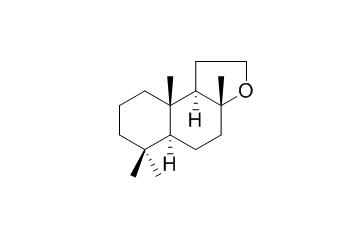Ambrox
Ambrox is a fragrance ingredient.
Inquire / Order:
manager@chemfaces.com
Technical Inquiries:
service@chemfaces.com
Tel:
+86-27-84237783
Fax:
+86-27-84254680
Address:
1 Building, No. 83, CheCheng Rd., Wuhan Economic and Technological Development Zone, Wuhan, Hubei 430056, PRC
Providing storage is as stated on the product vial and the vial is kept tightly sealed, the product can be stored for up to
24 months(2-8C).
Wherever possible, you should prepare and use solutions on the same day. However, if you need to make up stock solutions in advance, we recommend that you store the solution as aliquots in tightly sealed vials at -20C. Generally, these will be useable for up to two weeks. Before use, and prior to opening the vial we recommend that you allow your product to equilibrate to room temperature for at least 1 hour.
Need more advice on solubility, usage and handling? Please email to: service@chemfaces.com
The packaging of the product may have turned upside down during transportation, resulting in the natural compounds adhering to the neck or cap of the vial. take the vial out of its packaging and gently shake to let the compounds fall to the bottom of the vial. for liquid products, centrifuge at 200-500 RPM to gather the liquid at the bottom of the vial. try to avoid loss or contamination during handling.
VNU J Science: Med.&Pharm. Sci.2023, 39(2):43-52.
J Appl Biol Chem.2021, 64(3),263?268
Chemistry of Natural Compounds2018, 54(3):572-576
J Ethnopharmacol.2019, 236:31-41
Oncol Rep.2021, 46(1):143.
Ulm University Medical Center2020, doi: 10.18725.
Food Science and Biotechnology2023, 2023:1007
Pharm Biol.2017, 55(1):360-366
J.Korean Society of Grassland&Forage Science2023, 43(3):138-147.
Microchemical Journal2022, 182: 107874.
Related and Featured Products
Adv Biochem Eng Biotechnol. 2015;148:427-47.
Enzymes for synthetic biology of ambroxide-related diterpenoid fragrance compounds.[Pubmed:
25846965 ]
Ambrox and related Ambroxides are highly priced in the fragrance industry, and valued for their delicate odor and fixative properties.
METHODS AND RESULTS:
Historically, Ambrox was obtained from ambergris, a waxy excretion produced by sperm whales, now an endangered species. Synthetic Ambroxides have replaced ambergris in perfume manufacture. Plant labdane diterpenoids can serve as starting material for Ambroxide synthesis. Among these, the diterpene alcohol sclareol is the major industrial precursor obtained from cultivated clary sage (Salvia sclarea). In plants, a large family of diterpene synthase (diTPS) enzymes controls key reactions in diterpenoid biosynthesis. Advanced metabolite profiling and high-throughput sequencing of fragrant and medicinal plants have accelerated discovery of novel diTPS functions, providing a resource for combinatorial synthetic biology and metabolic engineering approaches.
CONCLUSIONS:
This chapter highlights recent progress on the discovery, characterization, and engineering of plant diTPSs with potential uses in Ambroxide production. It features biosynthesis of sclareol, cis-abienol, and diterpene resin acids, as sources of genes and enzymes for diterpenoid bioproducts.



